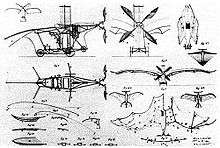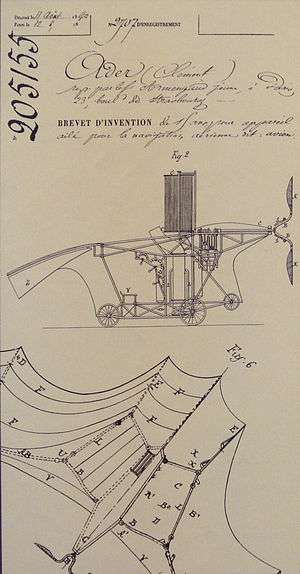Clément Ader
| Clément Ader | |
|---|---|
 | |
| Born |
2 April 1841 Muret, Haute-Garonne, France |
| Died |
3 May 1925 (aged 84) Toulouse, Haute Garonne, Occitanie, France |
| Nationality | French |
|
Engineering career | |
| Discipline | |
| Projects | |
| Significant design | |
| Significant advance | First self-propelled flight (1890) |
Clément Ader (2 April 1841 – 3 May 1925)[1] was a French inventor and engineer who was born in Muret, Haute-Garonne (a distant suburb of Toulouse), and died in Toulouse. He is remembered primarily for his pioneering work in aviation.
The inventor
Ader was an innovator in a number of electrical and mechanical engineering fields. He originally studied electrical engineering, and in 1878 improved on the telephone invented by Alexander Graham Bell. After this he established the telephone network in Paris in 1880. In 1881, he invented the théâtrophone, a system of telephonic transmission where listeners received a separate channel for each ear, enabling stereophonic perception of the actors on a set; it was this invention which gave the first stereo transmission of opera performances, over a distance of 2 miles (3 km) in 1881.[2] In 1903, he devised a V8 engine for the Paris–Madrid race, but although three or four were produced, none were sold.[3]
Development of aircraft

.jpg)
Following this, he turned to the problem of mechanical flight and until the end of his life gave much time and money to this. Using the studies of Louis Pierre Mouillard (1834–1897) on the flight of birds, he constructed his first flying machine in 1886, the Éole. It was a bat-like design run by a lightweight steam engine of his own invention, with 4 cylinders developing 20 horsepower (15 kW), driving a four-blade propeller. The engine weighed no more than 4 kg/kW (7 pounds per horsepower). The wings had a span of 14 m (46 ft). All-up weight was 300 kg (650 lb). On 9 October 1890 Ader attempted to fly the Éole. Aviation historians give credit to this effort as a powered take off and uncontrolled hop of approximately 50 m (160 ft) at a height of approximately 20 cm, (8 in).[4][5][6][7] Ader also claimed credit for getting off the ground in the Éole.[8]
Ader began construction of a second aircraft he called the Avion II, also referred to as the Zephyr or Éole II. Most sources agree that work on this aircraft was never completed, and it was abandoned in favour of the Avion III. Ader's later claim that he flew the Avion II in August 1892 for a distance of 100 m (330 ft) in Satory near Paris,[9] was never widely accepted.[5]

Ader's progress attracted the interest of the minister of war, Charles de Freycinet. With the backing of the French War Office, Ader developed and constructed the Avion III. It resembled an enormous bat made of linen and wood, with a 15 m (48 ft) wingspan, equipped with two four bladed tractor propellers, each powered by a steam engine of 30 hp (22 kW). Using a circular track at Satory, Ader carried out taxiing trials on 12 October 1897 and two days later attempted a flight. After a short run the machine was caught by a gust of wind, slewed off the track, and came to a stop. After this the French army withdrew its funding, but kept the results secret. The commission released in November 1910 the official reports on Ader's attempted flights, stating that they were unsuccessful.[10]
L'Aviation Militaire
Clément Ader remained an active proponent of the development of aviation. In 1909 he published L'Aviation Militaire, a very popular book which went through 10 editions in the five years before the First World War. It is notable for its vision of air warfare and its foreseeing the form of the modern aircraft carrier, with a flat flight deck, an island superstructure, deck elevators and a hangar bay. His idea for an aircraft carrier was relayed by the US Naval Attaché in Paris[11] and were followed by the first trials in the United States in November 1910.
An airplane-carrying vessel is indispensable. These vessels will be constructed on a plan very different from what is currently used. First of all the deck will be cleared of all obstacles. It will be flat, as wide as possible without jeopardizing the nautical lines of the hull, and it will look like a landing field.— Clément Ader, L'Aviation Militaire, 1909
Influence

Ader is still admired for his early powered flight efforts, and his aircraft gave the French language the word avion for a heavier-than-air aircraft. In 1938, France issued a postage stamp honoring him. Airbus named one of its aircraft assembly sites in Toulouse after him. Clément Ader has been referred to as "the father of aviation".[12][13]
See also
Notes
- ↑ "Les Obsèquies de Clément Ader". l'Aérophile: 301. 1 May 1925.
- ↑ Crook, Tim (1999-11-02). Radio drama: Theory and practice. pp. 15–16. ISBN 978-0-415-21603-6.
- ↑ G. N. Georgano Cars: Early and Vintage, 1886–1930. (London: Grange-Universal, 1985).
- ↑ Gibbs-Smith, Charles H. (3 Apr 1959). "Hops and Flights: A roll call of early powered take-offs". Flight. 75 (2619): 468. Retrieved 24 Aug 2013.
- 1 2 Encyclopedia Britannica: Clément Ader
- ↑ Carroll Gray, "Clement Ader 1841–1925"
- ↑ European Aeronautic Defence and Space Company EADS N.V.: Eole/Clément Ader" at the Wayback Machine (archived October 20, 2007)
- ↑ La première étape de l'aviation militaire en France Bibliothèque numérique en histoire des sciences et des techniques. Retrieved March 29, 2016.
- ↑ Gibbs-Smith2003 p.75
- ↑ Gibbs-Smith 2003, p. 75.
- ↑ "Sandcastle V.I. - Carriers: Airpower at Sea - The Early Years / Part 2". www.sandcastlevi.com. Retrieved 2008-09-17.
- ↑ "Clement Ader and the Aeroplane". Science. American Association for the Advancement of Science. 61 (1586): 533. 22 May 1925. doi:10.1126/science.61.1586.533. JSTOR 1648968.
- ↑ Zahm, Albert F. (1944/1945). "Conspectus of Early Powerplane Development". Records of the Columbia Historical Society. 46/47: 325–358. JSTOR 40067638. Check date values in:
|date=(help)
Further reading
- Lissarague, Pierre, Ader, Inventor of Aeroplanes. Tolouse, France: Editions Privat, 1990
- Lissarague, Pierre, Pegasus,the magazine of Musee de l'Air, Nos. 52, 56, 58, . (Articles on restoration of Ader's Aeroplane 3 and on the testing of engines and propellers.)
- Pierre Lissarague and J. Forestier, Icarus an article on restoration of Ader's Avion 3, No. 134 (October 1990).
- Gibbs-Smith C.H., Clement Ader, his Flight Claims and His Place in History. London: HMSO, 1968,
- Gibbs-Smith C.H., Aviation: An Historical Survey. London, NMSI, 2008. ISBN 1-900747-52-9
External links
![]() Media related to Clément Ader at Wikimedia Commons
Media related to Clément Ader at Wikimedia Commons
- Works by or about Clément Ader at Internet Archive
- Clement Ader
- Clement Ader's flying machines
- Clement Ader's first flight in 1879 ?
